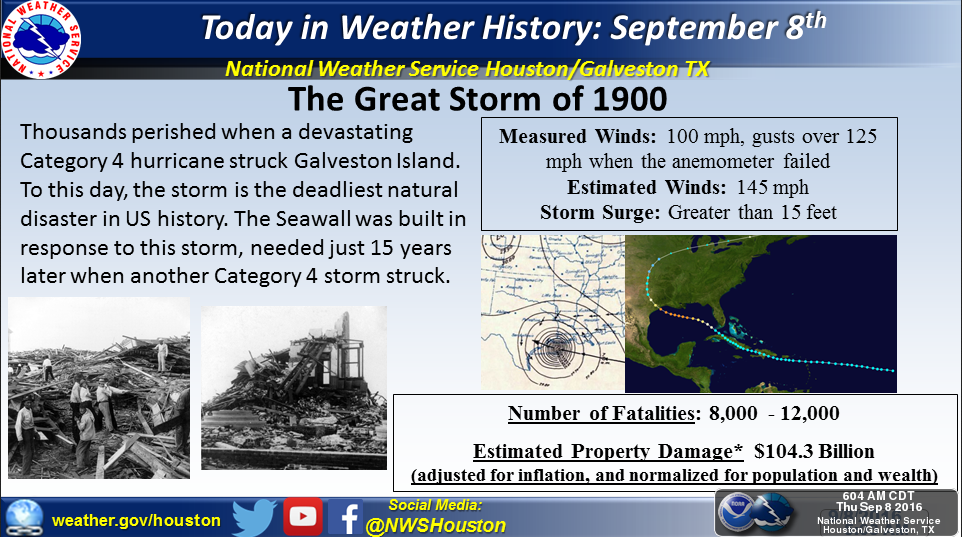Welcome to Galveston in 1900. A bustling city teaming with life and fancy hotels. The city of 38,000 has streets emblazoned with electric lights, the first of its kind in Texas, and the cities port is stuffed with ships bringing imports and immigrants. It's the New York of the South as it was called according to the Galveston County History Museum, more millionaires per capita than any U.S. city and the city is well positioned to become one of the most prosperous of the south.
Until September 8th, 1900.
A most devastating hurricane targeted a direct blow to the heart of Galveston. Believed to be a category four hurricane with winds of 145 mph, the storm struck with indiscriminate fury and within a matter of hours, Galveston was in ruins and the city of firsts: first hospital, first opera house, first post office, first country club according to Galveston.com, was gone.
With it, some 6,000 to 8,000 people were swept away -- so many bodies in fact that the crew on the steamship "Pensacola" reported they could smell the dead from sea according to the Smithsonian.
In the book "Isaac's Storm," a passage reads that if you stood with your back to the wind, the barometer would be lower on your left than on your right," an indication of the strength of the hurricane. Remember that the lower the pressure is, the stronger the storm. Below is a model of the 1900 by Dr. Phil Klotzbach of the pressure fields.
Animation of sea level pressure showing 1900 Galveston hurricane (~8000 fatalities) making landfall. pic.twitter.com/UnWekyG9ct
— Philip Klotzbach (@philklotzbach) September 8, 2016
The morning of September 9th was a peaceful, beautiful morning. With first light it was revealed that a third of the city was gone and a sixth of the population was dead.
In response to the hurricane, a great seawall was constructed beginning in 1902 according to the Texas Almanac. The wall stood 17 feet tall upon completion, was 15 feet thick at the base and five feet thick at the top. After several extensions throughout the years, the wall is now 10.4 miles long.
Ironically enough, Isaac Cline, head meteorologist at the weather bureau in Galveston in 1900, wrote an entry to the Galveston Daily News on July 15, 1891 that building a seawall in Galveston was a waste of time and money. Cline felt that it would be impossible for such a storm tide to affect Galveston due to its shallow waters and was quoted as saying, ''to think otherwise would be a grand delusion.''
In the years after the wall was built, the entire City of Galveston had to be raised -- some 500 blocks of it. Every house, every church, every public building had to be raised and was done so a quarter inch at a time with large jackscrews.
According to therealgalveston.com, the six million pound St. Patrick's Church had to be raised five feet high with 700 jackscrews. Some reports claim that the church along with 2,156 other structures were raised with jacks to the beat of a drum to make sure that the mules that turned the jacks would wench the buildings at the same height at the same time.
It's hard to get the same exact perspective that the citizens of Galveston would have had in 1900 being that no original elevation remains in the city proper after the raising of the island.
Over the years, the wall and the raised elevations has been proven to save the city from flooding and massive loss of life. In fact, just 15 years after the 1900 storm, a hurricane of equal strength hit Galveston head on but this time, only eight people were killed.
Other hurricanes such as the surprise hurricane of the 1940s, hurricane's Carla, Alicia and Ike have all battered the city but with relatively low surge damage thanks to a seawall that still stands as a memorial of sorts to the greatest disaster in U.S. history.


